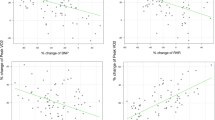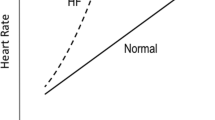Abstract
Objective: Although after pacing animal and human studies have demonstrated a rate-dependent effect of sotalol on ventricular repolarization, there is little information on the effects of sotalol on ventricular repolarization during exercise. This study attempted to show the effects of sotalol on ventricular repolarization during physiological exercise. Methods: Thirty-one healthy volunteers (18 males, 13 females) were enrolled in the study. Each performed a maximal treadmill exercise test according to the Bruce protocol after random treatment with sotalol, propranolol and placebo. Results: Sotalol significantly prolongedQTc (corrected QT) andJTc (corrected JT) intervals at rest compared with propranolol (QTc 324.86 ms. vs 305.21 ms,P<0.001;JTc 245.04 ms vs 224.17 ms,P<0.001) and placebo (QTc 324.86 ms vs 314.06 ms,P<0.01;JTc 245.04 ms vs 232.69 ms,P<0.001). TheJTc percent reduction increased progressively with each stage of exercise and correlated positively with exercise heart rate (r=0.148,P<0.01). TheJTc percent reduction correlation with exercise heart rate did not exist with either propranolol or placebo. Conclusions: These results imply that with sotalol ventricular repolarization is progressively shortened after exercise. Thus the specific class III antiarrhythmic activity of sotalol, present as delay of ventricular repolarization, may be attenuated during exercise. Such findings may imply the need to consider other antiarrythmic therapy during periods of stress-induced tachycardia.
Similar content being viewed by others
References
Antonaccio, M.J., Gomoll, A., 1993. Pharmacologic basis of the antiarrhythmic and hemodynamic effects of sotalol.Am J Cardiol,72(4):27A-37A.
Dai, D.Z., 1998. The perspective of development of new class III antiarrhythmic agents.Chin J Clin Pharmacol,14(3):181–185.
Funck-Brentano, C., Kibleur, Y., Le Coz, F., Poirier, J.M., Mallet, A., Jaillon, P., 1991. Rate dependence of sotalol-induced prolongation of ventricular repolarization during exercise in humans.Circulation,83:536–545.
Jurkiewicz, N.K., Sanguinetti, M.C., 1996. Rate-dependent prolongation of cardiac action potentials by a methane-sulfonanilide class III antiarrhythmic agent: specific block of rapidly activating delayed rectifier K+ current by dofetilide.Circ Rec,72:75–83.
Markel, M.L., Miles, W.M., Luck, J.C., Klein, L.S., Prystowsky, E.N., 1993. Differential effects of isoproterenol on sustained ventricular tachycardia before and during procainamide and quinidine antiarrhythmic drug therapy.Circulation,87:783–792.
Morady, F., Kou, W.H., Nelson, S.D., de Buitleir, M., Schmaltz, S., Kadish, A.H., Toivonen, L.K., Kushner, J.A., 1988. Accentuated antagonism between beta-adrenergic and vagal effects on ventricular refractoriness in human.Circulation,77:289–297.
Nakaya, H., Tohse, N., Takeda, Y., Kanno, M., 1993. Effects of MS-551, A new class III antiarrhythmic drug, on action potential and membrance currents in rabbit ventricular myocytes.Br J Pharmacol,109(1):157–163.
Roden, D.M., 1993. Usefulness of sotalol for life-threatening ventricular arrhythmias.Am J Cardiol,72:51A.
Sager, P.T., Follmer, C., Uppal, P., Pruitt, C., Godfrey, R., 1994. The effects of beta-adrenergic stimulation on the frequency-dependent electrophysiologic actions of amiodarone and sematilide in humans.Circulation,90(4):1811–1819.
Sagie, A., Larson, M.G., Goldberg, R.J., Bengtson, J.R., Levy, D., 1992. An improved method for adjusting the QT interval for heart rate (the Framingham heart study).Am J Cardiol,70:797–801.
Shimizu, W., Kurita, T., Suyama, K., Aihara, N., Kamakura, S., Shimomura, K., 1996. Reverse use dipendence of human ventricular repolarizition by chronic oral sotalol in monophasic action potential recordings.Am J Cardiol,77(11):1004–1008.
Suttorp, M.J., Kingma, J.H., Peels, H.O., Koomen, E.M., Tijssen, J.G., van Hemel, N.M., Defauw, J.A., Ernst, S.M., 1991. Effectiveness of sotalol in preventing supraventircular tachyarrythmias shortly after coronary artery bypass grafting.Am J. Cardiol,68:1163.
Vaughan Williams, E.M., 1985. Delayed ventricular repolarization as an anti-arrhythmic principle.European Heart Journal,6(suppl.D):145–149.
Wang, J.A., Lau, C.P., Tai, Y.T., Wu, B.Z., 1995. Effects of flecainide on exercise hemodynamics and electrocardiography in patients without structure heart disease.Clin Cardiol,18(3):140–144.
Author information
Authors and Affiliations
Rights and permissions
About this article
Cite this article
Jian, L., Jian-an, W. The effects of sotalol on ventricular repolarization during exercise. J Zheijang Univ Sci B 6, 249–253 (2005). https://doi.org/10.1007/BF02842460
Received:
Accepted:
Issue Date:
DOI: https://doi.org/10.1007/BF02842460




